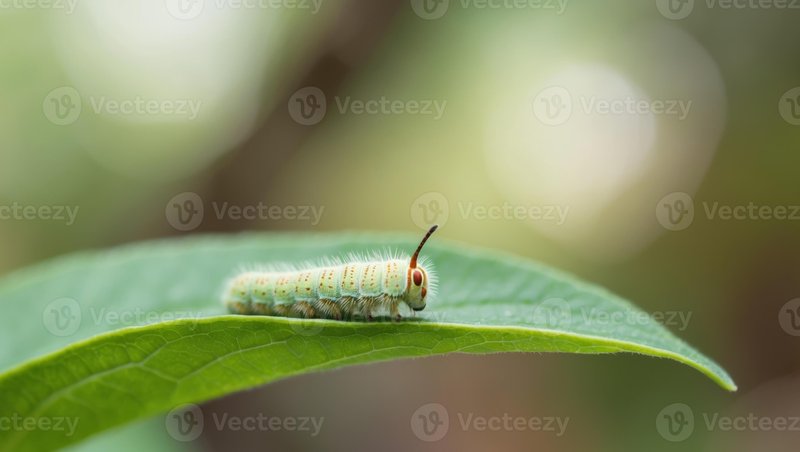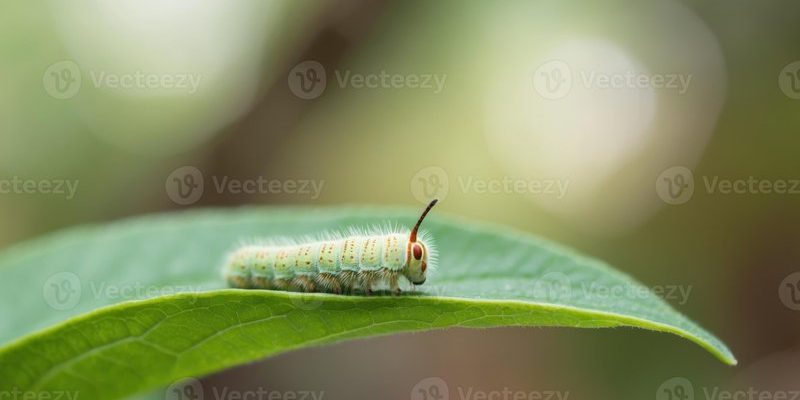
Think of inchworms as the unwelcome guests at a party. They may look small and harmless at first, but they can quickly become a nuisance, munching their way through leaves and weakening your trees in no time. But before you reach for chemical pesticides, let’s explore some natural, environmentally friendly alternatives to keep your trees safe and sound.
Understanding Inchworms: What Are They?
Inchworms are the larvae of various moth species, and they get their name from the way they move—by arching their bodies and then extending them, which looks like “inching” along. They come in various colors, often blending seamlessly with tree bark or leaves. These little guys love to feast on tree leaves, and when they gather in numbers, they can defoliate entire branches. If you’ve noticed that your trees are suddenly looking sparse, inchworms could be the reason.
It’s not just their munching that makes them a problem. Infested trees can stress out under the pressure, leading to susceptibility to diseases and other pests. When you see the telltale signs—like chewed leaves or even tiny droppings on the ground—you know it’s time to take action. So, what can you do to protect your beloved trees from these tiny tree munchers?
Regular Inspection: Your First Line of Defense
One of the best natural ways to protect trees from inchworm damage is through **regular inspections**. Just like you check for signs of illness or wear in your home, your trees need the same attention. Take a stroll around your yard, looking closely at the leaves and branches. Inspecting your trees regularly helps you catch problems early before they escalate.
Look for signs like chewed or distorted leaves, webbing, or the presence of actual inchworms. You might think, “I can’t see them if they blend in.” Here’s the thing: inchworms often hang from branches, and you can spot them easier if you look for movement or listen for their munching sound on leaves. If you catch them early, they’re much easier to manage.
If you’re finding lots of them, it might make sense to take extra steps to handle the situation before it spirals out of control. Just like with any pest issue, the sooner you act, the better.
Encouraging Natural Predators
Did you know that nature has its own way of controlling pests? That’s right! One of the most effective natural ways to protect trees from inchworm damage is by **encouraging natural predators**. Birds, wasps, and even certain types of beetles love munching on inchworms. By attracting these helpful creatures to your garden, you’re setting up a kind of pest control army!
To draw in birds, consider installing birdhouses or planting berry-producing shrubs. If you want to attract wasps, planting flowers like dill and fennel can help. Here’s a simple tip: the more biodiversity in your garden, the more likely you are to control unwanted pests naturally. When you provide a healthy environment, you’re also creating a welcoming habitat for beneficial insects and wildlife.
Another option is to introduce beneficial nematodes or predatory insects. These little wonders can help manage populations naturally, ensuring that inchworms don’t take hold in the first place. Just remember, balance is key; you want to maintain a healthy ecosystem, not disrupt it.
Homemade Sprays: Your DIY Arsenal
Sometimes, you need a little extra help in the battle against inchworms. That’s where **homemade sprays** come into play. You might be wondering what to mix up in your kitchen to deter these critters naturally. Luckily, there are a few simple recipes to try!
One popular method is a soap spray. Mix about 2 tablespoons of liquid soap (not detergent) with a gallon of water. Spray this mixture directly onto the leaves where you see inchworms. The soap clogs their breathing pores, effectively suffocating them. But remember, don’t apply this spray on sunny days; it could harm the leaves. Misting in the early morning or late afternoon works best.
Another option is a garlic spray. Blend a few cloves of garlic with water and let it sit overnight. Strain the mixture, and then spray it on affected trees. The strong smell of garlic will deter inchworms and other pests. Plus, your neighbors will be wondering what delicious meal you’re cooking up—bonus!
Using Diatomaceous Earth for Protection
You may have heard of **diatomaceous earth** (DE) as a gardening superhero. It’s a natural powder made from the fossilized remains of tiny aquatic organisms. Here’s why it’s helpful: the sharp edges of DE are harmless to plants and larger animals but can be lethal to small pests like inchworms.
Simply sprinkle a layer of diatomaceous earth around the base of your trees and on the leaves. When inchworms make contact, the powder lacerates their exoskeleton, leading to dehydration. It’s like a protective shield for your trees!
Remember, though, that DE works best when dry, so avoid applying it during rainy or humid days. Reapply every few weeks, especially after watering or rainfall, to maintain effectiveness.
Promoting Tree Health Through Pruning
Healthy trees are less likely to suffer from pest infestations. That’s where **pruning** comes in. Regularly pruning your trees promotes good health by improving airflow and light penetration, making it harder for pests like inchworms to settle in. Think of it as giving your trees a haircut to help them thrive!
When you prune, focus on removing any dead or infested branches. This not only helps the tree but also reduces the chance of inchworm populations booming. Make your cuts clean and at an angle to promote better healing. Here’s a tip: don’t prune too much at once. A little at a time is way better for the health of your plants.
And yes, you guessed it—pruning is also a great opportunity to check for any signs of inchworm activity. It’s like two birds with one stone!
Creating a Healthy Ecosystem
Finally, consider how to **create a healthy ecosystem** overall. A well-balanced environment supports trees and helps them fend off pests. Start by incorporating native plants into your landscape. They often require less maintenance and are naturally more resilient to local pests.
Additionally, avoid using chemical fertilizers and pesticides. They can harm beneficial insects and disrupt the natural balance. Instead, try organic compost to nourish your soil, leading to healthier, stronger trees that can withstand a bit of nibbling.
You might also want to plant a variety of flowers and herbs to attract beneficial insects. Think of it as a buffet for your garden’s little helpers. When you create an inviting space for natural predators, you’re less likely to see your trees ravaged by inchworms.
Protecting your trees from inchworm damage doesn’t have to rely on harsh chemicals or complicated procedures. By using regular inspections, encouraging natural predators, making homemade sprays, utilizing diatomaceous earth, pruning effectively, and creating a healthy ecosystem, you cover all your bases. Each method complements the others, contributing to a thriving environment for your trees.
Remember, healthy trees make for a beautiful landscape and a better habitat for wildlife. You might find that the more you care for your trees naturally, the less you’ll have to worry about pesky inchworms. So grab your gardening gloves, roll up your sleeves, and let’s keep those trees happy and healthy!

